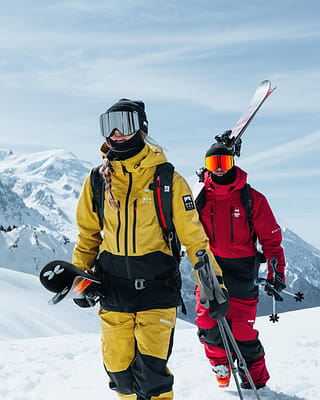How to adjust ski bindings
Correctly determining your DIN setting and other key adjustments can make the difference between a clean ski ejection and a painful twist you’d rather avoid. Yikes! So, make sure you’re dialed in with our quick-fire guide on how to adjust ski bindings.

Your DIN setting is a Goldilocks situation. Too tight, and you’re locked in for the ride. Too loose, and you risk popping out mid-carve. But getting your bindings right isn’t just about DIN – it’s also about pressure, toe height, heel positioning, and even centering.
So, what does that leave you with? A reason to read this article and make sure your settings are right, of course! Yes, these five simple steps will give you the confidence to rip, slash, and jump turn all the way to après. Oh, and if you’re changing up your settings, why not change up your style? Check out our new collection below.
Five steps to achieving properly set bindings
Measuring and adjusting forward pressure
Setting the toe piece (toe height adjustment)
Adjusting heel length
Setting the DIN value
Checking binding centering (optional adjustment)
1. Measuring and adjusting forward pressure
Forward pressure ensures the boot is held securely in place and helps the binding release properly during a fall. If the pressure is too low, your boot might pop out super easily, especially when you hit bumps or land jumps. However, if the forward pressure is overly high, the binding might not release when it should, increasing the risk of injury. Not ideal, right?
To set your forward pressure, look for the indicator (sometimes a small arrow or window) on your heel piece. Insert your boot all the way in, watching how that indicator lines up within the recommended range (or meets the specified mark). If it’s off, use the adjustment screw or lever to move the heel piece until the boot snaps in with a firm click (it won’t need excessive force). Then, flex or wiggle the boot gently for a final check. Does everything feel stable, and the indicator remains aligned? Congrats – you’ve nailed forward pressure! Just note that forward pressure indicators vary between brands – some use windows, arrows, or alignment lines. If in doubt, check your binding’s manual for exact positioning.
2. Setting the toe piece (toe height adjustment)

The toe piece holds the front of your boot while determining how easily it can pivot and release during a crash. The distance between your boot sole and the AFD (Anti-Friction Device) matters. That’s because too big a gap can create excess movement. However, too small a gap might prevent the binding from releasing correctly. So, find the sweet spot. This allows the boot to move just enough, helping the binding to do its job and let go when needed.
To dial in toe height, click your boot in and find the toe height screw near the front of the binding. Turn it until there’s about a 0.5 mm/0.01-inch gap between the boot sole and the AFD. You can use something thin to check the gap, such as a folded piece of paper. Slide the paper underneath the boot sole. You want a bit of resistance as you move the paper out. However, it shouldn’t be clamped tight. While you’re at it, ensure the area is free of dirt or snow. A clean, properly adjusted toe piece maximizes comfort, prevents weird squeaks or slips, and reduces the risk of unwanted releases on the hill.
3. Adjusting heel length
Heel length adjustment ensures your boot sits correctly in the binding from back to front. If it’s off, you can experience early or random releases because the boot isn’t seated right. On the flip side, a heel piece set overly tight can be tough to step into and might compromise the binding’s ability to release when you stack it. Think of this step as perfecting the ‘lock-in’ point that ensures a smooth, secure ride.
To adjust, locate the heel length screw (usually behind the heel piece) and loosen or tighten it to slide the piece forward or backward. Step in with your boot to test the fit. Ideally, you’ll feel a firm – but not forceful – ‘click’ and no noticeable wiggle. If it’s tough to step in, back off the screw a bit. If you sense too much freedom, move the heel piece closer. Once it’s just right, your boot should pop in smoothly. Now, the binding is prepped to release properly when necessary.
4. Setting the DIN value

The DIN value controls how easily your bindings release in a crash, factoring in your weight, height, skiing ability, and boot sole length. A lower DIN means easier release, which is safer for beginners or lighter skiers. Advanced or heavier skiers favor a higher DIN to prevent accidental releases. However, a higher DIN also requires more force to pop out. Striking the right balance is crucial: go too low, and your skis might come off when you don’t want them to. Go too high, though, and they might stay on when they shouldn’t.
Start by referencing an online DIN calculator or chart. Then, use your personal stats (weight, height, skill level, and boot sole length) to find your setting. Once you have that number, locate the small screw and scale on both the toe and heel pieces. Turn until the DIN indicator lines up with your target setting, and make sure it’s the same on both ends to ensure proper release mechanics. New to adjusting bindings? Be sure to have a ski tech do a final check. While online calculators and charts are great for estimating your DIN setting, they’re for reference only. Since your DIN setting plays a big role in your safety, it’s worth spending the extra time to get it dialed in properly.
5. Checking binding centering (optional adjustment)
Some riders tweak the sweet spot of their bindings on the ski. Shifting them forward can enhance quick, playful turns — great for slalom or moguls — while moving them back can deliver more stability and float in powder. Casual resort skiers might skip this step. However, if you’re chasing specific performance benefits or just love to experiment, this step is something to consider. Remember that every centimeter and inch counts, and small moves can make a big difference in how your skis handle terrain.
Are your bindings on a rail system? Loosen a lever or screw to slide them into a new position with minimal hassle. Step back in and see how it feels. Like the new balance? Lock it down. Are your bindings drilled into the ski? Any major shift requires a shop visit and possibly new holes. So, unless you really know your stuff, it’s best to let a pro do that job. Once you’re happy with your placement, you’ll experience a ski that’s more tuned to your style and terrain preference.

Wrapping up
Well, that’s it – our five-step, quick-fire guide to adjusting your ski bindings. Be safe out there. And, remember – if you’re unsure about anything, ask an experienced ski tech to double-check your work. Happy trails!
Need more help or information? Reach out to us at crew@montecwear.com and bend our ears! Just want to let us know if this article was handy? We’d love to know that, too.
Related reading:


